|
|
|
Sort Order |
|
|
|
Items / Page
|
|
|
|
|
|
|
| Srl | Item |
| 1 |
ID:
179916
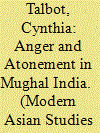

|
|
|
|
|
| Summary/Abstract |
Anger as an emotion is seldom attributed to Akbar (r. 1556–1605), the most admired of the Mughal emperors. Yet, on one notable day in 1578, he allegedly got so enraged that he almost lost his mind, according to Dalpat Vilas, an obscure chronicle composed in the vernacular. While the aftermath of Akbar's anger was reported in several Persian histories emanating from court circles, the royal rage itself was not. Why and how Dalpat Vilas ascribed anger, not only to the emperor but also to the local king, Raja Ray Singh of Bikaner, is the central issue addressed here. What little we know about the history of anger in precolonial India indicates it was an emotion that kings were advised to avoid, in both Sanskrit and Persian literature. But, from the more subaltern vantage point of Dalpat Vilas, written for a young Rajput warrior in a local dialect, rulers did act angrily and not always justly. This case illustrates the historiographic value of Indic-language texts sponsored by local subordinates of the Mughals, which can provide alternative perspectives on the empire. It also suggests the existence of multiple emotional communities in Mughal India, in which the significance of anger differed.
|
|
|
|
|
|
|
|
|
|
|
|
|
|
|
|
| 2 |
ID:
179918


|
|
|
|
|
| Summary/Abstract |
In the late nineteenth and early twentieth centuries, monumental Muslim tombs in India served as spaces for refashioning local religious and social identities. Elite patrons, technical overseers, and stoneworkers engaged with new technologies of construction at sites meant to reflect claims on the Muslim past. This article interrogates divergent class understandings of monumental Muslim tombs in colonial-era India. It compares the construction of monumental Islamic tombs in the states of Hyderabad, Bhopal, and Rampur—three Muslim-led ‘native states’, quasi-autonomous polities under colonial oversight. By the late nineteenth century, many native state patrons employed a new middle class of technical intermediary to oversee tomb construction. The rise of this class created new hierarchies within construction, with apprenticeship-trained master craftsmen increasingly marginalized from state narratives and aligned with stoneworkers and other labourers. While patrons and middle-class intermediaries argued that new technologies and materials should be used to ‘modernize’ construction, they portrayed technical change as divorced from the religious symbolism of tombs. In contrast, workers integrated the religious and the technical, positioning technologies of construction within narratives of Muslim practice. The article uses native state tombs to analyse how labourers adapted to technical demands, without necessarily adopting state ideologies.
|
|
|
|
|
|
|
|
|
|
|
|
|
|
|
|
| 3 |
ID:
179923
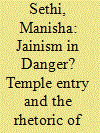

|
|
|
|
|
| Summary/Abstract |
A bitter debate broke out in the Digambar Jain community in the middle of the twentieth century following the passage of the Bombay Harijan Temple Entry Act in 1947, which continued until well after the promulgation of the Untouchability (Offences) Act 1955. These laws included Jains in the definition of ‘Hindu’, and thus threw open the doors of Jain temples to formerly Untouchable castes. In the eyes of its Jain opponents, this was a frontal and terrible assault on the integrity and sanctity of the Jain dharma. Those who called themselves reformists, on the other hand, insisted on the closeness between Jainism and Hinduism. Temple entry laws and the public debates over caste became occasions for the Jains not only to examine their distance—or closeness—to Hinduism, but also the relationship between their community and the state, which came to be imagined as predominantly Hindu. This article, by focusing on the Jains and this forgotten episode, hopes to illuminate the civilizational categories underlying state practices and the fraught relationship between nationalism and minorities.
|
|
|
|
|
|
|
|
|
|
|
|
|
|
|
|
| 4 |
ID:
179922
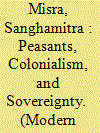

|
|
|
|
|
| Summary/Abstract |
This article studies two seismic decades in the history of the Garo community, marked out in colonial records as among the most violent and isolated people that British rule encountered in eastern and northeastern India. Through a densely knit historical narrative that hinges on an enquiry into the colonial reordering of the core elements of the regional political economy of eastern and northeastern India, it will train its focus on the figure of the rebellious Garo peasant and on the arresting display of Garo recalcitrance between 1807 and 1820. Reading a rich colonial archive closely and against the grain, the article will depart from extant historiography in its characterization of the colonial state in the early nineteenth century as well as of its relationship with ‘tribes’/‘peasants’ in eastern and northeastern India. A critique of the idea of primitive violence and the production of the ‘tribe’ under conditions of colonial modernity will occupy the latter half of the article. Here it will argue that the numerous and apparently disparate acts of headhunting, raids, plunder, and burning by the Garos on the lowlands of Bengal and Assam were in fact an assembling of the first of a series of sustained peasant rebellions in this part of colonial India—a powerful manifestation of a community's historical consciousness of the loss of its sovereign self under British rule.
|
|
|
|
|
|
|
|
|
|
|
|
|
|
|
|
| 5 |
ID:
179921


|
|
|
|
|
| Summary/Abstract |
This article deals with an 1849 semi-autobiographical manuscript, ‘Ishqnama, from Avadh (present-day Uttar Pradesh), to explore the courtly politics of the last nawab (ruler) of Avadh, Wajid ‘Ali Shah. I argue that, in the ‘Ishqnama, a language of love and sex exists and portends a logic of political comportment and control between ruler and lover, ruler and servant. After surveying the importance and meaning of the manuscript during Wajid ‘Ali Shah's reign, I examine the dissemination of the handwritten manuscript via lithograph copies, tracing the specific textual and visual elements that have been obfuscated and manipulated in the transition from a handwritten design to print technology. I argue that the political content of the ‘Ishqnama has been neglected because of the material differences between the lithograph copies and the manuscript format and because of the sexual nature of the ‘Ishqnama narrative.
|
|
|
|
|
|
|
|
|
|
|
|
|
|
|
|
| 6 |
ID:
179920
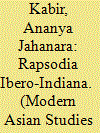

|
|
|
|
|
| Summary/Abstract |
The mando is a secular song-and-dance genre of Goa whose archival attestations began in the 1860s. It is still danced today, in staged rather than social settings. Its lyrics are in Konkani, their musical accompaniment combine European and local instruments, and its dancing follows the principles of the nineteenth-century European group dances known as quadrilles, which proliferated in extra-European settings to yield various creolized forms. Using theories of creolization, archival and field research in Goa, and an understanding of quadrille dancing as a social and memorial act, this article presents the mando as a peninsular, Indic, creolized quadrille. It thus offers the first systematic examination of the mando as a nineteenth-century social dance created through processes of creolization that linked the cultural worlds of the Indian and Atlantic Oceans—a manifestation of what early twentieth-century Goan composer Carlos Eugénio Ferreira called a ‘rapsodia Ibero-Indiana’ (‘Ibero-Indian rhapsody’). I investigate the mando's kinetic, performative, musical, and linguistic aspects, its emergence from a creolization of mentalités that commenced with the advent of Christianity in Goa, its relationship to other dances in Goa and across the Indian and Atlantic Ocean worlds, as well as the memory of inter-imperial cultural encounters it performs. I thereby argue for a new understanding of Goa through the processes of transoceanic creolization and their reverberation in the postcolonial present. While demonstrating the heuristic benefit of theories of creolization to the study of peninsular Indic culture, I bring those theories to peninsular India to develop further their standard applications.
|
|
|
|
|
|
|
|
|
|
|
|
|
|
|
|
| 7 |
ID:
179919


|
|
|
|
|
| Summary/Abstract |
In 1919, Afghanistan embarked on a series of reforms that led to the presence of Afghan students at various European universities, facilitating the circulation of peoples, ideas, and goods. Focusing on one of these cases, this article examines how an Afghan student engaged critically with ‘Western’ art and translated artistic ideas and technologies through the grid of Afghanistan's own history of the fine arts. Through an exploration of the work of Abdul Ghafur Brechna (1907–1974)—artist, music composer, poet, and writer—I argue that, despite his desire to train at German technical schools, Brechna translated, then connected, his Western training to restore Afghanistan's traditional visual and literary arts, making it problematic to define his oeuvre as purely ‘modern’ or ‘traditional’. The first aim is to situate Brechna within the intellectual milieu of Weimar Germany, placing emphasis on how he curated the course of his education to support his aims. By tracing out the evolution of his artistic knowledge to Afghanistan, the second part of this article connects his earlier training to the newly emerging scholars in Kabul who also grappled with national renewal and an ‘Aryan’ literary and cultural heritage. Lastly, I discuss his attempt to rewrite the history of the arts by closely analysing his visual and literary work, emphasizing in particular his attempt to reconnect to themes and genres that had previously been lost or neglected.
|
|
|
|
|
|
|
|
|
|
|
|
|
|
|
|
| 8 |
ID:
179917
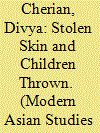

|
|
|
|
|
| Summary/Abstract |
What did women's bodies in pre-colonial South Asia have to do with the birth of capitalism? South Asia's pre-colonial integration into a globally emerging, early modern capitalist order reached deep into the hinterland to transform both state and society in eighteenth-century Marwar. Driving the change was an emergent elite, consisting largely of merchants, that channelled its energies towards reshaping caste. Merchants, in alliance with Brahmans, used their influence upon the state to adjudicate the boundary between the ‘illicit’ and the ‘licit,’ generating in the process a typology and an archive of deviant sex. In the legal framework that generated this archive, women were configured as passive recipients of sexual acts, lacking sexual personhood in law. Even as they escaped legal culpability for ‘illicit’ sex, women experienced, through this body of judgments, a strengthening of male proprietary controls over their bodies. Alongside, the criminalization of abortion served as a means of sexual disciplining. These findings suggest that post-Mughal, pre-colonial state formation in South Asia intersected with global economic transformations to generate new sex-caste orders and archival bodies.
|
|
|
|
|
|
|
|
|
|
|
|
|
|
|
|
|
|
|
|
|